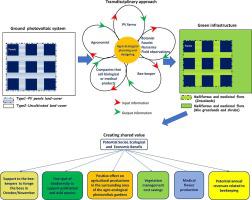Ecosystem Services ( IF 6.1 ) Pub Date : 2022-06-25 , DOI: 10.1016/j.ecoser.2022.101450
Teodoro Semeraro , Aurelia Scarano , Angelo Santino , Rohinton Emmanuel , Marcello Lenucci

|
Biodiversity and crop productivity are compromised by the ongoing worldwide decline of pollinator insects primarily driven by the narrow specialization of modern agricultural industry, dominated by monocultures and characterized by intensive herbicide and pesticide inputs. This approach has the double drawback of indiscriminately killing both invasive and beneficial insects while pauperizing the landscape limiting the areas of natural vegetation that normally provide habitat for pollinators. Here, an approach to develop green infrastructures (GI) is proposed (Ground Photovoltaic farms, GPv) to synergistically address ecological emergencies and socio-economic needs. Mainly, we focused on Nature-based Solutions (NbS) to foster pollination as a priority ecosystem service and medicinal herb production as a co-benefit, creating a shared value in the landscape. The results suggest that the replacement of ruderal herbaceous vegetation with selected autochthonous cultivated species in the area of GPv farms could increase land revenues by simultaneously improving the pollination ecological network and agricultural activities. The economic analysis of the proposed solutions indicates that the annual return rate of the initial investment for GPv farms-to-GI conversion is between 9 and 43%, with potential payback in three years. Hence, GI could become an ecological business model, capable of improving ecosystem services in the landscape, both private and public benefits. However, a transdisciplinary approach is important to share knowledge across the different stakeholders and bridge the information gaps typical of a sectoral perspective, creating a holistic vision of the involved professional skills and experiences. Its proper implementation requires the joint effort of all economic stakeholders together with technical and scientific experts to promote multifunctional land-use in GPv farms.
中文翻译:

将太阳能光伏花园与农业生产和生态系统服务相结合的创新方法
全球范围内传粉昆虫的持续下降损害了生物多样性和作物生产力,这主要是由现代农业产业的狭隘专业化驱动,以单一栽培为主,并以密集的除草剂和杀虫剂投入为特征。这种方法具有不加选择地杀死入侵性昆虫和有益昆虫的双重缺点,同时使景观变得贫瘠,限制了通常为传粉媒介提供栖息地的自然植被区域。在这里,提出了一种发展绿色基础设施 (GI) 的方法(地面光伏农场,GPv),以协同解决生态紧急情况和社会经济需求。主要是,我们专注于基于自然的解决方案 (NbS),以促进授粉作为优先生态系统服务和药草生产作为共同利益,在景观中创造共享价值。结果表明,在 GPv 农场地区用选定的本土栽培物种替代粗生草本植物可以通过同时改善授粉生态网络和农业活动来增加土地收入。对提议的解决方案的经济分析表明,GPv 农场到 GI 转换的初始投资年回报率在 9% 到 43% 之间,三年内有潜在回报。因此,地理标志可以成为一种生态商业模式,能够改善景观中的生态系统服务,包括私人和公共利益。然而,跨学科方法对于在不同利益相关者之间共享知识并弥合部门视角典型的信息差距非常重要,对所涉及的专业技能和经验创造一个整体的视野。它的正确实施需要所有经济利益相关者以及技术和科学专家的共同努力,以促进 GPv 农场的多功能土地利用。































 京公网安备 11010802027423号
京公网安备 11010802027423号